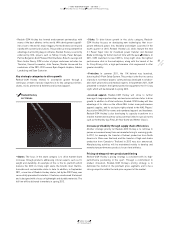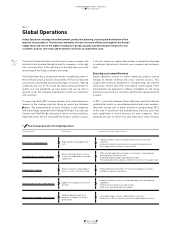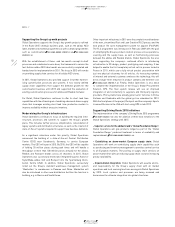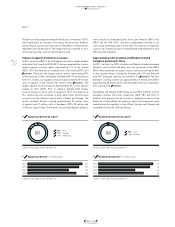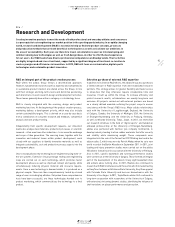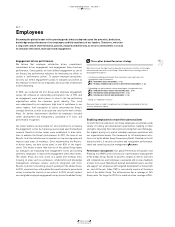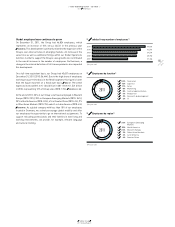Reebok 2011 Annual Report Download - page 99
Download and view the complete annual report
Please find page 99 of the 2011 Reebok annual report below. You can navigate through the pages in the report by either clicking on the pages listed below, or by using the keyword search tool below to find specific information within the annual report.
adidas Group
2011 Annual Report
GROUP MANAGEMENT REPORT – OUR GROUP
95
2011
02.6 Research and Development
Research and Development
Creating innovative products to meet the needs of both professional and everyday athletes and consumers
is a prerequisite to strengthening our market position in the sporting goods industry. In a rapidly changing
world, research and development (R&D) is essential to help us find new product concepts, processes
and production methods that are both beneficial to the business as well as facilitate our ambitions in
the area of sustainability. Each year, we therefore invest considerable resources into developing and
commercialising new technologies as well as fresh design ideas, in order to offer the best experience
for our users. Our R&D teams have diverse professional competencies and backgrounds. Their activities
are highly integrated and cross-functional, supported by a significant degree of functional co-location to
create synergies and efficiencies in innovation. In 2012, R&D will focus on customisation, digital sports
technologies and sustainable product innovation.
02.6
R&D an integral part of the product creation process
R&D within the adidas Group follows a decentralised approach.
However, fundamental research as well as expertise and competencies
in sustainable product creation are shared across the Group. In line
with their strategic and long-term visions and distinctive positioning,
each brand runs its own research, design and develop ment activities.
These teams generally have either a category or a technology focus.
R&D is closely integrated with the sourcing, design and product
marketing functions. At the beginning of the product creation process,
marketing defines a development priority, which may also include
certain sustainability targets. This is derived on a case-by-case basis
from a combination of consumer research and feedback, competition
analysis and own product testing.
Independently from specific development requests, our innovation
teams also analyse new materials, production processes or scientific
research – often even from other industries – to increase the exchange
and scope of idea generation. The sourcing team, together with the
innovation and material teams within product development, work
closely with our suppliers to identify innovative materials as well as
integrate sustainability, cost and production process aspects into the
development phase.
Once conceptualised, new technologies are engineered using state-of-
the-art systems. Extensive virtual prototype testing and engineering
loops are carried out on each technology, which promotes faster
development phases as well as improved concept and quality, while
simultaneously reducing physical material and resource require-
ments. Once a new technology is deemed viable, it is produced as a
physical sample. These are then comprehensively tested by a broad
range of users including top athletes. Only when these comprehensive
tests have been successful, are these technologies handed over to
product marketing, which commercialises the technology to a final
product.
Selective purchase of external R&D expertise
In addition to its internal R&D efforts, the adidas Group also purchases
a limited amount of R&D expertise from well-established research
partners. This strategy allows for greater flexibility and faster access
to know-how that may otherwise require considerable time and
resources if built up within the Group. To increase efficiency and
protect research results, collaborations are usually long-term and
exclusive. All projects carried out with external partners are based
on a clearly defined mandate outlining the project scope to ensure
consistency with the Group’s R&D focus. Major adidas relationships
exist with the University of Loughborough, England, the University
of Calgary, Canada, the University of Michigan, USA, the University
of Erlangen-Nuremberg and the University of Freiburg, Germany,
as well as Waseda University, Tokyo, Japan. In 2011, we intensified
our research initiatives in the field of “digital sports” and funded an
endowed professorship at the University of Erlangen-Nuremberg.
adidas also partnered with German tyre company Continental, to
develop industry-leading traction rubber materials that offer security
and stability while minimising weight. These compounds were
integrated into the sole of the Terrex Fast R GTX hiking boot and in the
adizero adios 2, which was worn by Patrick Makau when he set a new
world record at the Berlin Marathon in September 2011. In 2011, joint
loading and injury prevention studies were carried out on the adidas
f50 adizero football boot in association with the University of Freiburg.
Also in 2011, specific basketball and running performance studies
were carried out at the University of Calgary. These formed an integral
part of the development of the adizero Crazy Light basketball shoe
and adizero adios running shoe. In 2011, Reebok also continued its
research with R&D institutes around the world, which included testing
on EasyTone footwear with Arizona State University, EasyTone apparel
with Colorado State University and lacrosse biomechanics with the
University of Las Vegas. In 2011, TaylorMade-adidas Golf continued its
long-term cooperation with researchers at the University of Calgary,
with extensive joint swing dynamic studies, identifying the influence of
shaft variations on player performance and perception.






